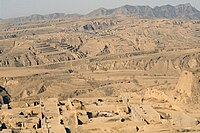
Photo from wikipedia
Extensive loess deposits exist in the Western Qinling Mountains (WQM), which constitute the transition zone between the Tibetan Plateau and the Chinese Loess Plateau (CLP). These deposits are one of… Click to show full abstract
Extensive loess deposits exist in the Western Qinling Mountains (WQM), which constitute the transition zone between the Tibetan Plateau and the Chinese Loess Plateau (CLP). These deposits are one of the most important terrestrial archives regarding past dust activity and environmental changes in East Asia; however, they remain insufficiently known and poorly understood. Herein, we conducted detailed quartz optically stimulated luminescence dating and multi‐proxy analysis on the Zhouqu loess sequence. Our results show that the loess on the high terrace of the Bailong River started to accumulate by at least ~60 ka. The mass accumulation rate (MAR) in Zhouqu significantly varied during the Last Glacial period. The Marine Isotope Stage (MIS) 3 MARs were relatively high and stable. The highest MAR occurred in MIS 2, with peak MARs during 25–19 ka, and it decreased with rapid changes during the Holocene. The discrepancy in the MARs of the WQM loess since the Last Glacial period compared with the rates in the CLP may imply different dust deposition processes in the WQM. The reconstructed palaeoenvironmental records indicate climate changes with warm‐moist climate patterns and low dust flux in interglacial periods and cold‐dry conditions with high dust flux in glacial periods, consistent with those on the CLP. The results contribute to better understanding of the linkages between dust accumulation and climate change in the WQM area.
Journal Title: Boreas
Year Published: 2020
Link to full text (if available)
Share on Social Media: Sign Up to like & get
recommendations!